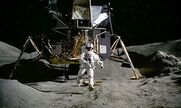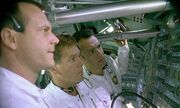But also because of the pursuit of truth, many of the dialogues inside are the same as real aerospace engineering, using abbreviations. It is difficult for friends who do not have this foundation, especially Chinese audiences, to understand, and to a certain extent, it also affects the Appreciation of the film. I’m not talented, I’ll sort out and translate the acronyms used in the film here. If there are omissions or errors, I hope you can correct me.
The following abbreviations are listed in alphabetical order.
BMAG (Body-mounted Attitude Gyro): Attitude gyroscope (a set of strapdown gyroscopes that provide a backup attitude reference for the attitude stabilization and control system. "Strapdown" means to measure the rate of change of attitude rather than absolute attitude)
BPC ( Boost Protective Cover: The propulsion protective cover (the cover attached to the launch escape tower is covered on the command module during the rocket's ascending section through the atmosphere, to isolate the heat generated by air friction and the high-temperature jet generated once the escape rocket is ignited )
Capcom (Capsule Communicator): Spaceship communicator (not the name of the Japanese game company...)
CM (Command Module): Command Module (The only component that the Apollo system completes the entire journey to the moon and returns to Earth with the help of insulation is that Cone-shaped small spacecraft)
CMP (Command Module Pilot): Command cabin pilot (the astronaut who operates the command service cabin, piloting the spacecraft during docking, engine ignition, and reentry)
CSM (Command and Service Module): Command service cabin ( Apollo spacecraft as a whole until reentry)
ECS (Environmental Control System): Environmental Control System (a set of subsystems responsible for the temperature and air supply of the spacecraft)
EDS (Emergency Detection System): Emergency Detection System (a detection system that detects whether the flight status of the Saturn V rocket exceeds the predetermined limit range. Automatically start the abort procedure or provide relevant information to the astronauts for them to manually start the abort procedure)
EECOM (Electrical, Environmental and Communications): electrical, environmental and communications (the name of a console in the mission control room is also responsible for the console The name of the technician in the field, due to changes in the division of responsibilities, the communication function has been separated from the control position, but the abbreviation is still used)
FIDO (Flight Dynamics Officer): Flight Dynamics Officer (controlling a console in the mission control room) Personnel, the responsibility is to plan the orbit of the command service cabin to the moon)
GDC (Gyro Display Coupler): Gyro Display Coupler (a group of gyroscopes of the spacecraft's standby attitude reference system, which is mainly used to provide attitude data for certain instruments during reentry. You can use the "GDC align" button to input the attitude data of the main attitude reference system into the system)
GNC (Guidance, Navigation and Control): Guidance, navigation and control (determine where the spacecraft is, where you want it to go, and how to get there The process is also the name of a console in the mission control room)
IMU (Inertial Messurement Unit): Inertial Measurement Unit (the gyroscope of the main attitude reference system, composed of a gyroscope stabilized platform and a set of telescopic support gimbals)
LCG ( Liquid Cooled Garment: Liquid Cooled Garment (a layer in the spacesuit, which uses liquid flow to control the temperature of the spacesuit)
LM (Lunar Module): Lunar Module (the second-level spacecraft used to transport astronauts from the orbit of the moon to the surface of the moon and bring them back to the command module, pronounced "lem")
NASA (National Astronautics and Space Administration) : National Aeronautics and Space Administration (the agency responsible for the operation of the US space program)
PTC (Passive Thermal Control): Passive Thermal Control (in order to maintain the uniform temperature of all parts of the spacecraft, a control method to make the spacecraft move slowly)
RCS (Reaction Control System) : Jet control system (a group of small rocket engines arranged around the spacecraft to control its attitude and perform small translational maneuvers)
Retro (Retrofire Officer): brake ignition officer (a console in the mission operation control room, responsible for Draw the possible orbit of the return to the earth)
RTCC (Real Time Computer Complex): Real Time Computer Center (a group of IBM 360 large computers in the Houston Mission Control Center, used to process the data required for flight)
SCS (Stabilization and Control System): Stabilization and Control System Control system (the backup system of the guidance and navigation system in the command cabin, using the attitude reference provided by the attitude gyro to complete the work)
SM (Service Module): Service Module (the cylindrical part of the Apollo spacecraft, used to load most of the consumables and propulsion System)
SPS (Service Propulsion System): service cabin propulsion system (the large rocket engine in the service cabin is used to enter and return from the lunar orbit)
TLI (Translunar Injection): enter the lunar orbit (send the spacecraft from the earth orbit) A large engine ignition into the moon orbit)
VOX (Voice Operated Transmission): Voice-activated transmission (a working mode in which the astronaut’s microphone is automatically turned on when there is a call)
View more about Apollo 13 reviews











